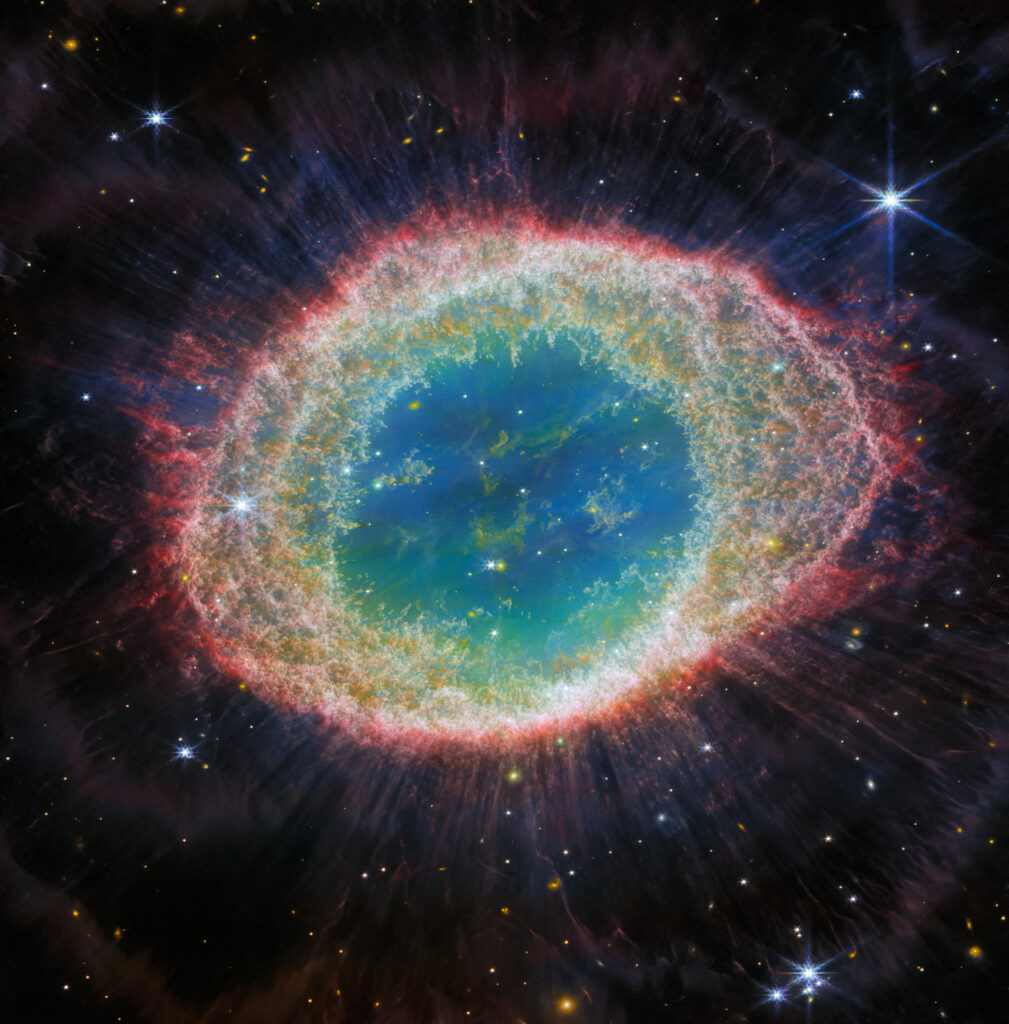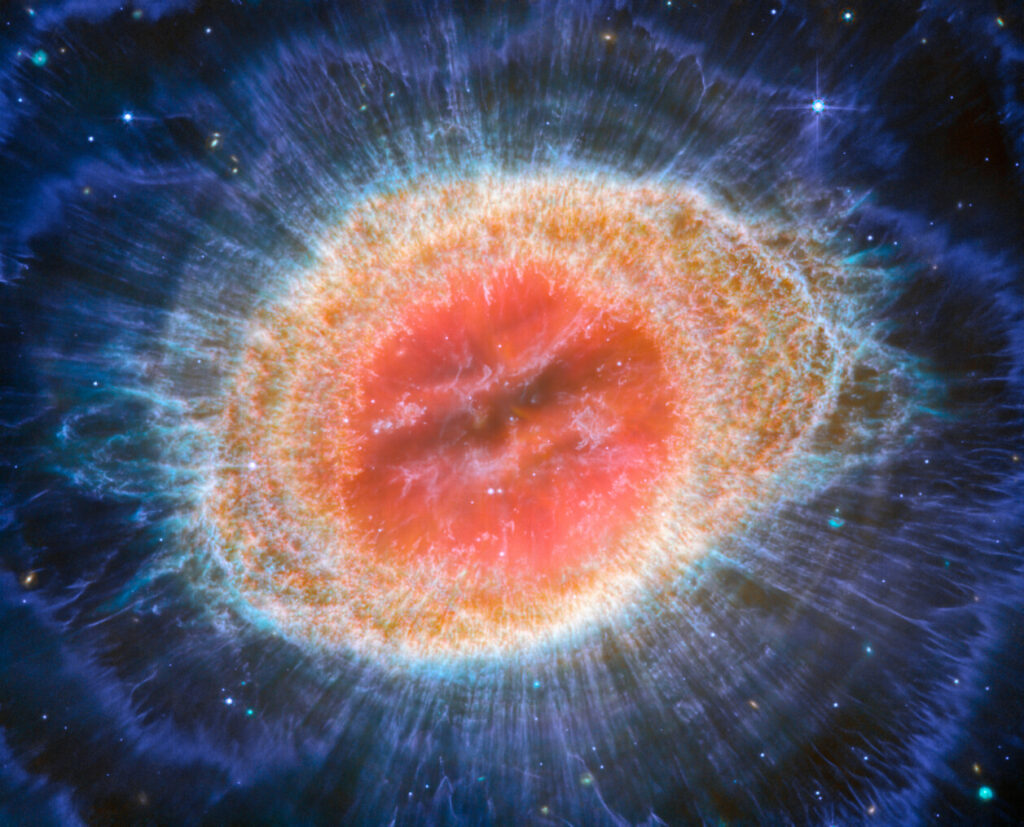Webb Stunning Images of the Ring Nebula Revealed Features That May Explain Its Shape
Brussels, 23 August 2023 – The James Webb Space Telescope (JWST) has recorded breathtaking new images of the iconic Ring Nebula, one of the best-known planetary nebulae. Those images were publicly released this month by an international team of astronomers, which includes Griet Van de Steene and Peter van Hoof, researchers of the Royal Observatory of Belgium. In a paper submitted to MNRAS and published in arXiv on August 21, the team presents and analyses features revealed by those images, one of which suggesting the presence of a star companion that may contribute to shape the Ring Nebula into its elliptic form.
Approximately 2,200 light-years away from Earth, the Ring Nebula is a well-known object that is located in the constellation Lyra. It can be observed all summer long with binoculars on a dark night-sky in the northern hemisphere and much of the southern. A small telescope will already reveal the characteristic donut-like structure of glowing gas that gave the Ring Nebula its name. It is a planetary nebula, which is the colourful remnants of dying stars that have thrown out much of their mass at the end of their lives.
The Ring Nebula’s distinctive structure and its vibrant colours have long captivated the human imagination. Stunning visuals of the nebula captured by Webb’s NIRCam (Near-Infrared Camera) and MIRI (Mid-Infrared Instrument) instruments were publicly released this month, on August 3 and August 20, 2023, and offer an opportunity to the public to admire this cosmic marvel and to the scientists to study and understand the complex processes that shaped it.
The new images not only display details of the nebula’s expanding shells but also the inner region around the central white dwarf with clarity. In a paper published in arXiV on August 21, 2023, a team of scientists, which includes Griet Van de Steene and Peter van Hoof of the Royal Observatory of Belgium, described and analysed Ring Nebula’s features revealed by these images.

NASA’s James Webb Space Telescope has observed the well-known Ring Nebula in unprecedented detail. Formed by a star throwing off its outer layers as it runs out of fuel, the Ring Nebula is an archetypal planetary nebula. This new image from Webb’s NIRCam (Near-Infrared Camera) shows intricate details of the filament structure of the inner ring. There are some 20,000 dense globules in the nebula, which are rich in molecular hydrogen. In contrast, the inner region shows very hot gas. The main shell contains a thin ring of enhanced emission from carbon-based molecules known as polycyclic aromatic hydrocarbons (PAHs). Download the full-resolution version from the Space Telescope Science Institute. Credit: ESA/Webb, NASA, CSA, M. Barlow (University College London), N. Cox (ACRI-ST), R. Wesson (Cardiff University)
The authors show that the ‘ring’ of the nebula is composed of about 20,000 individual clumps of dense hydrogen gas globules, each of them about as massive as the Earth. They also detected inside it polycyclic aromatic hydrocarbon (PAH), which are known as one of the building materials required for the earliest form of life, a thing that we would not expect to form in the Ring Nebula.
The Webb images also showed curious ‘spikes’ outside the ring pointing directly away from the central star, which are prominent in the infrared but were only very faintly visible in Hubble Space Telescope images. The researchers think these could be due to molecules that can form in the shadows of the densest parts of the ring, where they are shielded from the direct, intense radiation from the hot central star.
Finally, the authors discover in the faint halo outside the ring ten concentric arcs. They think that those arcs suggest the presence of a companion star in the system, orbiting about as far away from the central star as Pluto does from our Sun and sculpting the Nebula to its form that may be otherwise spherical.

This new image of the Ring Nebula from Webb’s MIRI (Mid-InfraRed Instrument) reveals particular details in the concentric features in the outer regions of the nebulae’s ring. Roughly ten concentric arcs located just beyond the outer edge of the main ring. The arcs are thought to originate from the interaction of the central star with a low-mass companion orbiting at a distance comparable to that between the Earth and Pluto. Download the full-resolution version from the Space Telescope Science Institute. Credit: ESA/Webb, NASA, CSA, M. Barlow (University College London), N. Cox (ACRI-ST), R. Wesson (Cardiff University).
The never-before-seen details of Webb images provide a wealth of new scientific insights into the processes of stellar evolution. By studying the Ring Nebula with the James Webb Space Telescope, scientists hope to gain a deeper understanding of the life cycles of stars and the elements they release into the cosmos.
The authors of the paper are part of a scientist’s team named ESSENcE (Evolved StarS and their Nebulae in the JWST Era), is composed experts in planetary nebulae and related objects. Inside this team, Griet Van de Steene and Peter van Hoof study nebulae using imagery and spectroscopy.
The paper: Wesson et al., JWST observations of the Ring Nebula (NGC 6720): I. Imaging of the rings, globules, and arcs, Submitted to Monthly Notices of the Royal Astronomical Society, published online in arXiv: arXiv:2308.09027 [astro-ph.SR], DOI: https://doi.org/10.48550/arXiv.2308.09027
See also NASA press release: https://blogs.nasa.gov/webb/2023/08/21/webb-reveals-intricate-details-in-the-remains-of-a-dying-star/
